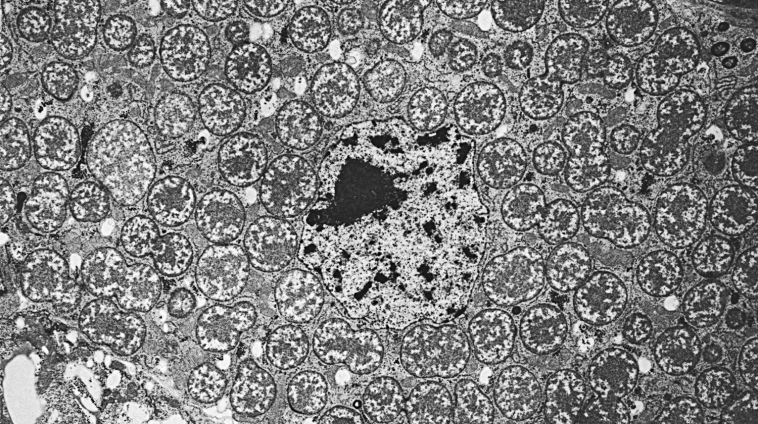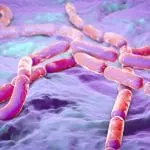[Originally published as Minimal Genomes. Click for image credit]
Prokaryotic (single-celled) organisms are among the smallest and simplest organisms on the planet. Because of this, they have been used heavily for minimal genome research. Because minimal genomes have ranged in size widely since the idea was proposed (see Mushegian, 1999; Itaya, 1995; and Mushegian and Koonin, 1996), some have proposed that there is no universal minimal genome, but instead, each taxon has its own (Hunyen, 2000).
Moya et al (2002) determined that a species of Buchnera was in the process of reducing its genome as a result of adopting a mutualistic lifestyle with an aphid. This idea seems to point to a reduction of genes, functional or otherwise, as a result of a lifestyle change.
Due to various selective pressures, most prokaryotic genomes are kept very small and limited to mostly functional genes (Graur, 2016). Yet this species of Buchnera is losing genes that, presumably, are functional to adapt to a new lifestyle. This seems to imply that the lost genes are not essential to keeping Bunchera alive. While this may seem contradictory, it is not.
An analogy to cars may be helpful. Many parts are required to make a car run: an engine, wheels, a steering wheel, fuel, and so on. Yet there are many features on vehicles that are not necessary yet still provide a function. The air conditioning system could be removed, and the car would still run. The same could be said for windshield wipers, hubcaps, fenders, the clock radio, and airbags. All of those things are perfectly functional (provided the car was manufactured and maintained correctly), but you do not need them to run the car.
The reason this works is that air conditioning is irrelevant to the function of the car. The car’s primary function is to transport its passengers from point A to point B. This function is not dependent on the passengers being comfortable for the trip. Obviously, we humans much prefer to be comfortable, but removing an AC unit from a vehicle will not cause the car to stop working. The only reason the AC unit is present is to increase the comfort of the passengers. That is its function. It makes the car more attractive to the mutualist who provides fuel to the car in exchange for transport.
The idea can be applied to the concept of a minimal genome.
For a cell to be alive, there are certain functions it needs to be able to perform. It needs to be able to intake nutrients, it needs to be able to reproduce itself and so on. Genes that code for these functions must be retained. The same cannot be said for genes that allow it to move or provide antibiotic resistance. These are non-essential to life and, while functional, can be removed without directly killing the organism. Thus, it is not a contradiction for a mostly functional prokaryotic genome to exist yet contain genes that are not essential to life.
I don’t think there is a single minimal genome. I agree with Hunyen (2000), that each taxonomic group likely has its own minimal genome. As I see it, the concept of a minimal genome must take into account environmental conditions. There are too many variables involved.
It seems straightforward that minimal genomes are dependent on the relationship with the host, the idea being that the more functions the host performs, the less the parasite or symbiote needs to do and, therefore, the fewer genes it needs.
What relevance does the question of a minimal genome have to the creation/evolution debate?
Consider the original creation. There would have been no parasites or diseases. In the post-fall world, organisms had to adapt to these lifestyles. One way they could do so was by ejecting genes that they no longer needed. Hence essentially minimizing their genome. This is why I expect that no universal minimal genome will ever be found. Each kind requires unique genes to accomplish its various tasks.
References
- Chow V.T.K. Sakharkar K.R. Dhar P.K. 2004. Genome reduction in prokaryotic obligatory intracellular parasites of humans: a comparative analysis. Int J Syst Evol Microbiol. 54(6):1937-1941.
- Graur D. 2016. Molecular and genome evolution. 1st. Sunderland, (MA). Sinauer Associates, Inc. 453.
- Hunyen M. 2000. Constructing a minimal genome. Trends Genet. 16(3):116.
- Itaya M. 1995. An estimation of minimal genome size required for life. FEBS Lett. 362(3):257-260.
- Moya A. Gil R. Sabater-Munoz B. Latorre A. Silva F.J. 2002. Extreme genome reduction in Buchnera spp.: toward the minimal genome needed for symbiotic life. Proc Natl Acad Sci U S A. 99(7):4454-4458.
- Mushegian A. 1999. The minimal genome concept. Curr Opin Genet Dev. 9(6):709-714.
- Mushegian A.R. Koonin E.V. 1996. A minimal gene set for cellular life derived by comparison of complete bacterial genomes. Proc Natl Acad Sci U S A. 93(19):10268-10273.






